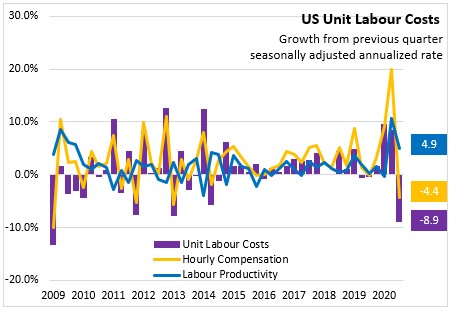The Economics and Statistics Division maintains archives of previous publications for accountability purposes, but makes no updates to keep these documents current with the latest data revisions from Statistics Canada. As a result, information in older documents may not be accurate. Please exercise caution when referring to older documents. For the latest information and historical data, please contact the individual listed to the right.
<--- Return to Archive
For additional information relating to this article, please contact:
November 05, 2020US PRODUCTIVITY, Q3 2020 The US Bureau of Labor Statistics (BLS) has released preliminary productivity estimates for the third quarter of 2020. All figures are reported as growth from the previous quarter at seasonally adjusted annualized rates.

Nonfarm business sector labour productivity in the US increased 4.9 per cent in Q3 2020, following revised increase of 10.6 per cent in Q2. With the exception of the second quarter, productivity growth in Q3 2020 was the largest quarterly increase since the fourth quarter of 2009.
Output increased at an annualized rate of 43.5 per cent in Q3 compared to a 36.8 per cent decline in Q2. Hours worked increased at an annualized rate of 36.8 per cent compared to a 42.9 per cent decline in Q2. These were the largest gains on record for the output and hours series.
US unit labour costs decreased 8.9 per cent on a 4.4 per cent decline in hourly compensation and 4.9 per cent gain in productivity. The decline in unit labour cost for Q3 was the largest since the first quarter of 2009.

Manufacturing sector labour productivity increased 19.0 per cent in Q3, as output increased 54.8 per cent and hours worked increased 30.1 per cent. These were largest increases on record for all three series, which date back to 1987.
The increase in manufacturing productivity was concentrated in durable goods, where productivity increased 44.2 per cent. Durable goods manufacturing output increased 96.0 per cent and hours worked rose 35.9 per cent in Q3. For nondurable goods manufacturing productivity increased 1.2 per cent, as output increased 22.7 per cent and hours worked grew by 21.2 per cent.
Unit labour costs across all manufacturing sectors decreased 18.2 per cent in Q3, the largest decline since the first quarter of 1993.
Notes:
Labour productivity, or output per hour, is calculated by dividing an index of real output by an index of hours worked by all persons, including employees, proprietors, and unpaid family workers. Unit labour costs are calculated as the ratio of hourly compensation to labour productivity; increases in hourly compensation increase unit labour costs while increases in productivity (output per hour) reduce unit labour costs. US manufacturing output is calculated on a different basis than for all nonfarm businesses, so these series are not directly comparable.
BLS quarterly estimates of labour productivity combine output data with hours worked data based primarily on BLS Current Employment Statistics (CES) survey and supplemented with data from the Current Population Survey (CPS). The March reference period for these surveys largely predated many of the COVID-19-related job losses that occurred in the latter part of March. To capture these job losses, adjustments were made to employment and hours using supplementary data which are reflected in Q1 2020 hours worked and related measures. BLS found that adjustments applied to the second quarter produced results similar to the standard methodology. Therefore, BLS did not apply adjustments for Q2.
Source: US Bureau of Labor Statistics
<--- Return to Archive